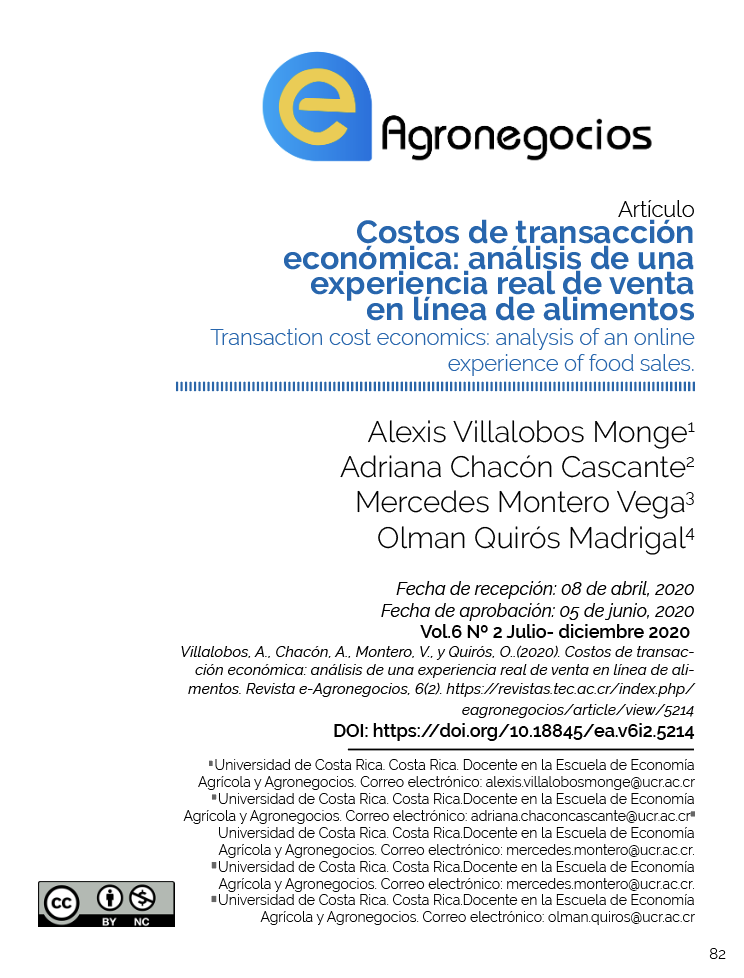Transaction cost economics: analysis of an online experience of food sales.
Main Article Content
Abstract
The objective of this article is to estimate the perception of the time invested in food purchases over the Internet, as an approximation of transaction costs. The predictor variables of the consumer's response to the time perception and its level of association with transaction costs are also evaluated. The perception of time spent through different channels such as farmers markets, supermarkets and online was compared with the effective time of these transactions. The information is based on the Stimulus-Organism-Response theory (S-O-R) through the use of structural equations. The data was obtained from 223 surveys of people who made online food purchases through the agrifood products portal of the University of Costa Rica during the period February-November 2019, it was possible to find that the perception of time to buy food online is longer than it really takes. It was also possible to verify that the hedonic variables (pleasure when visiting the website as well as the time invested in the purchase) have a strong relationship with the perception of transaction costs that the food consumer must take into account. The conclusions are presented for its application both from an academic and business point of view.
Article Details

This work is licensed under a Creative Commons Attribution-NonCommercial 4.0 International License.
Las personas autoras conservan los derechos de autor/a y ceden a la revista el derecho de la primera publicación y que pueda editarlo, reproducirlo, distribuirlo, exhibirlo y comunicarlo en el país y en el extranjero mediante medios impresos y electrónicos. Asimismo, las personas autoras asumen el compromiso sobre cualquier litigio o reclamación relacionada con derechos de propiedad intelectual, exonerando de responsabilidad a la Editorial Tecnológica de Costa Rica. Además, se establece que los autores pueden realizar otros acuerdos contractuales independientes y adicionales para la distribución no exclusiva de la versión del artículo publicado en esta revista (p. ej., incluirlo en un repositorio institucional o publicarlo en un libro) siempre que indiquen claramente que el trabajo se publicó por primera vez en esta revista.
References
Arslan, O., Archetti, C., Jabali, O., Laporte, G., & Grazia Speranza, M. (2019). Minimum cost network design in strategic alliances. Omega, 102079. https://doi.org/10.1016/j.omega.2019.06.005
Beaujean, A. A. (2014). Latent Variable Modeling Using R: A Step-by-Step Guide. Routledge. https://doi.org/10.4324/9781315869780
Bollen, K. A. (1987). Total, Direct, and Indirect Effects in Structural Equation Models. Sociological Methodology, 17, 37. https://doi.org/10.2307/271028
Cai, S., & Xu, Y. (2006). Effects of outcome, process and shopping enjoyment on online consumer behaviour. Electronic Commerce Research and Applications, 5(4), 272-281. https://doi.org/10.1016/j.elerap.2006.04.004
Chan, T. K. H., Cheung, C. M. K., & Lee, Z. W. Y. (2017). The state of online impulse-buying research: A literature analysis. Information & Management, 54(2), 204-217. https://doi.org/10.1016/j.im.2016.06.001
Coase, R. H. (1937). The Nature of the Firm. Economica, 4(16), 386-405. https://doi.org/10.1111/j.1468-0335.1937.tb00002.x
Fang, J., George, B., Shao, Y., & Wen, C. (2016). Affective and cognitive factors influencing repeat buying in e-commerce. Electronic Commerce Research and Applications, 19, 44-55. https://doi.org/10.1016/j.elerap.2016.08.001
Floh, A., & Madlberger, M. (2013). The role of atmospheric cues in online impulse-buying behavior. Electronic Commerce Research and Applications, 12(6), 425-439. https://doi.org/10.1016/j.elerap.2013.06.001
Gefen, D. (2000). E-commerce: The role of familiarity and trust. Omega, 28(6), 725-737. https://doi.org/10.1016/S0305-0483(00)00021-9
INEC. (2019). ENAHO | INSTITUTO NACIONAL DE ESTADISTICA Y CENSOS. http://www.inec.go.cr/ingresos-y-gastos-de-hogares/ingresos-de-los-hogares
Kacen, J. J., Hess, J. D., & Kevin Chiang, W.-Y. (2013). Bricks or Clicks? Consumer Attitudes toward Traditional Stores and Online Stores. Global Economics and Management Review, 18(1), 12-21. https://doi.org/10.1016/S2340-1540(13)70003-3
Kim, C., Galliers, R. D., Shin, N., Ryoo, J.-H., & Kim, J. (2012). Factors influencing Internet shopping value and customer repurchase intention. Electronic Commerce Research and Applications, 11(4), 374-387. https://doi.org/10.1016/j.elerap.2012.04.002
Kline, R. (2011). Principles and practice of structural equation modeling (Tercera Ed.). The Guilford Press.
Liao, C., Liu, C.-C., & Chen, K. (2011). Examining the impact of privacy, trust and risk perceptions beyond monetary transactions: An integrated model. Electronic Commerce Research and Applications, 10(6), 702-715. https://doi.org/10.1016/j.elerap.2011.07.003
Lin, J., Lu, Y., Wang, B., & Wei, K. K. (2011). The role of inter-channel trust transfer in establishing mobile commerce trust. Electronic Commerce Research and Applications, 10(6), 615-625. https://doi.org/10.1016/j.elerap.2011.07.008
Martínez-López, F. J., Pla-García, C., Gázquez-Abad, J. C., & Rodríguez-Ardura, I. (2014). Utilitarian motivations in online consumption: Dimensional structure and scales. Electronic Commerce Research and Applications, 13(3), 188-204. https://doi.org/10.1016/j.elerap.2014.02.002
Pavlou, P. A. (2003). Consumer Acceptance of Electronic Commerce: Integrating Trust and Risk with the Technology Acceptance Model. International Journal of Electronic Commerce, 7(3), 101-134.
PIMA. (2017). Tendencias de Consumo – PIMA. http://www.pima.go.cr/tendencias-de-consumo/
Ramlall, I. (2017). Applied Structural Equation Modelling for Researchers and Practitioners: Using R and Stata for Behavioural Research: Vol. First edition. Emerald Group Publishing Limited. http://search.ebscohost.com/login.aspx?direct=true&db=e000xww&AN=1423582&site=ehost-live&scope=site
Smith, V. L. (1989). Theory, Experiment and Economics. Journal of Economic Perspectives, 3(1), 151-169. https://doi.org/10.1257/jep.3.1.151
Teo, T. S. H., & Yu, Y. (2005). Online buying behavior: A transaction cost economics perspective. Omega, 33(5), 451-465. https://doi.org/10.1016/j.omega.2004.06.002
Villalobos-Monge, A., & Sánchez-Chacón, L. (2013). Caracterización del consumo de hostalizas en las familias del Sur-Sur de Costa Rica. Agronomía Mesoamericana, 24(1), 37-46.
Williamson, O. E. (1989). Chapter 3 Transaction cost economics. En Handbook of Industrial Organization (Vol. 1, pp. 135-182). Elsevier. https://doi.org/10.1016/S1573-448X(89)01006-X
Wright, R., Tekin, E., Topalli, V., McClellan, C., Dickinson, T., & Rosenfeld, R. (2017). Less Cash, Less Crime: Evidence from the Electronic Benefit Transfer Program. Journal of Law & Economics, 60(2), 361-383. https://doi.org/10.1086/693745
Xu-Priour, D. L., Cliquet, G., & Palmer, A. (2017). The Influence of Buyers’ Time Orientation on Online Shopping Behavior: A Typology. International Journal of Electronic Commerce, 21(3), 299-333. https://doi.org/10.1080/10864415.2016.1319206

